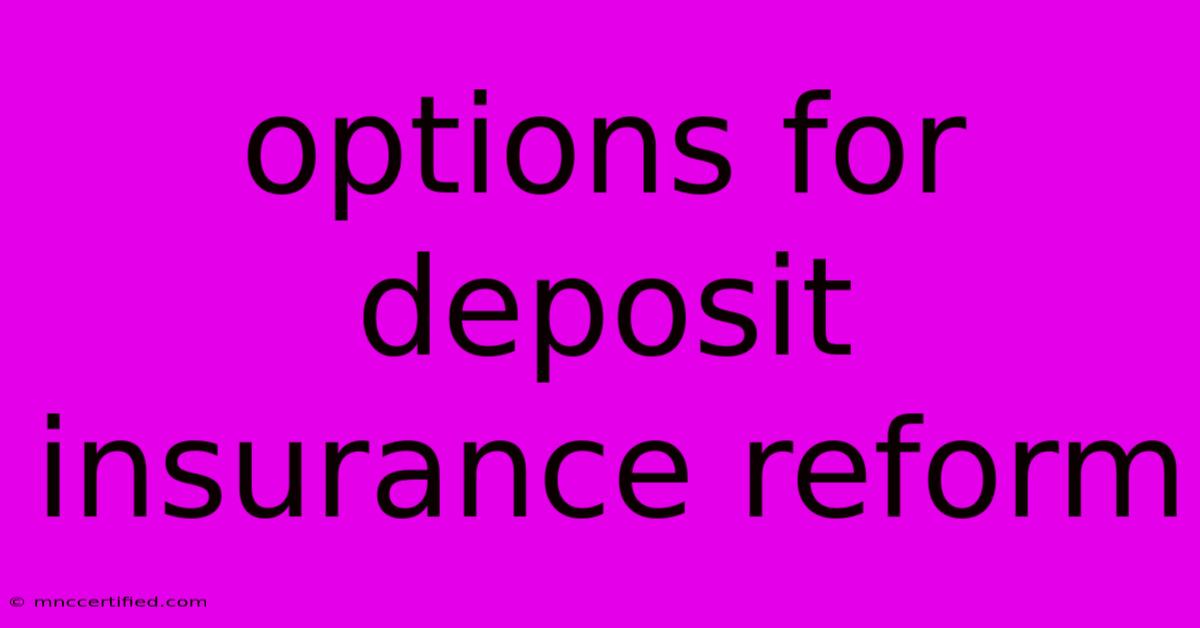Options For Deposit Insurance Reform

Table of Contents
Options for Deposit Insurance Reform: A Deep Dive
Deposit insurance is a vital component of the financial system, providing peace of mind to depositors and contributing to financial stability. However, in the wake of recent economic events and evolving banking landscapes, the need for deposit insurance reform is increasingly being discussed. This article explores various options for deposit insurance reform, examining their potential benefits and drawbacks.
The Current State of Deposit Insurance
The current deposit insurance system in the United States is largely based on the FDIC (Federal Deposit Insurance Corporation), which guarantees deposits up to $250,000 per depositor, per insured bank. This system has generally been effective in preventing runs on banks and maintaining public confidence. However, several challenges have emerged:
- Rising Deposit Balances: The average deposit balance has grown significantly in recent years, putting greater strain on the FDIC's resources in case of a large bank failure.
- Systemic Risk: The interconnectedness of the banking system means that the failure of a large institution can have significant spillover effects, potentially destabilizing the entire system.
- Technological Advancements: The emergence of new financial technologies, such as cryptocurrencies and fintech platforms, presents unique challenges for deposit insurance and raises questions about its applicability.
Options for Deposit Insurance Reform
Several options for deposit insurance reform are being considered to address these challenges:
1. Raising Deposit Insurance Limits
This option involves increasing the amount of deposits covered by insurance, providing greater protection to depositors. While this could enhance public confidence and reduce the risk of bank runs, it could also lead to moral hazard (where banks take on more risk knowing their depositors are protected) and increase the FDIC's potential liabilities.
2. Expanding Deposit Insurance Coverage
This option explores expanding deposit insurance to cover new types of financial products and institutions, such as money market funds, cryptocurrencies, and fintech platforms. This could broaden the scope of protection, but it also raises complex questions about how to define these products and institutions and how to manage the associated risks.
3. Introducing Risk-Based Premiums
This approach involves charging banks higher premiums for deposit insurance based on their risk profile. This could incentivize banks to adopt sound risk management practices and potentially reduce the FDIC's overall financial burden. However, designing a fair and effective risk-based premium system can be challenging and may require sophisticated risk modeling and data collection.
4. Establishing a Systemic Risk Buffer
This option proposes creating a dedicated fund or buffer to absorb losses from large bank failures that pose systemic risks. This could mitigate the impact of bank failures on the broader financial system and prevent a domino effect. However, establishing and maintaining such a buffer would require significant upfront investment and ongoing contributions from financial institutions.
5. Exploring a "Too Big to Fail" Regime
This option considers the potential for regulatory changes that limit the size and interconnectedness of large financial institutions. This could reduce the potential for systemic risks and simplify the management of deposit insurance. However, implementing such a regime would be complex and politically sensitive, requiring careful consideration of its potential impact on financial innovation and competition.
Conclusion: A Balancing Act
Deposit insurance reform is a complex and multifaceted issue, with no easy answers. A comprehensive approach is crucial, addressing the challenges of rising deposit balances, systemic risks, and technological advancements while preserving the core principles of depositor protection and financial stability.
It is crucial to weigh the benefits and drawbacks of each option carefully, considering their potential impact on bank lending, financial innovation, and the overall economic landscape. Further research, stakeholder engagement, and careful policy implementation are essential to ensure that deposit insurance reform effectively serves its purpose of safeguarding the financial system while supporting a vibrant and dynamic economy.

Thank you for visiting our website wich cover about Options For Deposit Insurance Reform. We hope the information provided has been useful to you. Feel free to contact us if you have any questions or need further assistance. See you next time and dont miss to bookmark.
Featured Posts
-
Haaland Transfer Euro Giants Battle For Star
Nov 11, 2024
-
Wolf Hall The Real Cromwells End
Nov 11, 2024
-
Armistice Day Starmer Macron To Meet In Paris
Nov 11, 2024
-
Halifax Car Insurance Contact Number
Nov 11, 2024
-
Bitcoin Tops 81 K Will It Hit 100 K
Nov 11, 2024